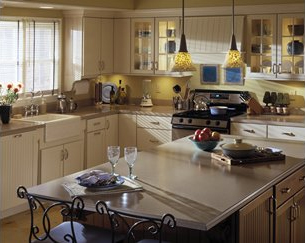Cabinet Re-facing
Cabinet re-facing is a term that is not generally understood by the public. There are two methods of re-facing a cabinet. The first method would be to cover the shell (carcass) of the cabinet with a piece of plastic laminate similar to what is used on a laminated countertop. The technician then uses a router to create the openings for the doors and drawers. The doors and drawer fronts are then replaced with MDF or similar material that has been laminated. Since I do not offer or even recommend this method; that is about all I know about it.
The second method is to use a real wood veneer and solid wood doors and drawer fronts. This is a method that I both recommend and do on a regular basis. Considering that this is an investment of your hard earned money and not just a cost, you should expect a return on that investment, I certainly would. This method is far more likely to give you a dollar for dollar return if not more.
Process: The sides of the cabinets are covered with a veneered piece of ¼” plywood which is glued to the surface with a high-strength adhesive. The face frame, which is made up of stiles and rails, is then covered with a two-ply wood veneer.
The stiles of a cabinet face frame are the vertical pieces of wood that support the doors and the rails are the horizontal pieces of wood that connect to the stiles forming the openings of the cabinets. The veneer is cut in individual pieces and applied in the same pattern that the cabinet is actually constructed. Once the process is complete it would take a rather trained eye to distinguish between a new cabinet and one that has been professionally refaced.
Since veneer will not easily go around the rounded edges of your existing doors and drawer fronts, it is necessary to replace the doors and drawer fronts. This is where the options become nearly unlimited. Keep in mind that the value of kitchen cabinets is generally relative to the quality of the doors and the hardware. If you have a sturdy cabinet carcass with a solid wood face frame then you are a candidate for cabinet re-facing.
The veneer is finished in a factory setting along with the replacement doors and drawer fronts, so you're assured of consistency and the same high quality found in a new cabinet finish. You will find a diverse array of door styles to choose from on the scroll bar at the top of this page.
When you are going through the process of re-facing it is also an opportune time to think about replacing the slides on any drawers that are not functioning properly, modifying the cabinet over the stove and replacing that old vented hood with a new vented microwave oven, replacing the cabinet over the refrigerator with a 24” deep cabinet, adding storage space as well as accessibility, and boxing in the refrigerator itself. You can also add sliding shelves to the lower cabinets or a lazy-susan in those hard to reach corner cabinets. There are many storage conveniences available on the market today that will help make your kitchen user-friendlier.
Advantages: You can generally save up to 40% of the total replacement cost of comparable new cabinets. You are not limited to using all of your old cabinets; you can add new cabinets and/or a myriad of features to expand storage space, etc. If you are not replacing your countertops, re-facing is the safest method to upgrade your cabinets. Removing Granite, Corian or any Solid Surface material counter-top is difficult to say the least and there is no guarantee that the top can be salvaged successfully without some damage.
Disadvantages: The obvious disadvantage comes into play when you want to completely redesign your kitchen, such as moving the refrigerator and cook-tops, etc to other parts of the kitchen. Re-facing is only suitable if you are satisfied with the present day layout of the kitchen; shy a few modifications or what I refer to as minor surgery. In addition, re-facing is probably not the answer if you desire to refinish the inside of the cabinets; the labor cost is generally prohibitive.


